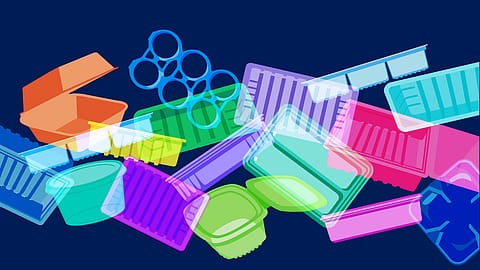Single-use Plastic: India’s Battle Far From Over
Major drivers of this single-use plastic problem are the booming e-commerce and food delivery sectors.

This story belongs to the Fortune India Magazine October 2024 issue.
IN BUSTLING MARKETPLACES across India, single-use plastic products remain ubiquitous. From crowded streets of metros to remote villages, the relentless dumping of plastic waste highlights the pressing environmental crisis that continues to unfold. Recent data reveals the country’s consumption of single-use plastics is alarmingly high, with implications for sustainability and public health. India, the world’s second-most populous country, produced approximately 9.46 million tonnes plastic waste in 2023, according to Central Pollution Control Board. Alarmingly, nearly 43% of this was single-use plastic, which includes items like plastic bags, straws, cutlery and packaging materials that are typically discarded after one use.
Major drivers of this problem are the booming e-commerce and food delivery sectors. Industry reports say in 2023, India’s e-commerce market accounted for 1.2 MT plastic waste, much of it single-use. E-commerce plastic packaging market size was $23.34 billion in 2023. Food delivery sector is another big contributor, generating approximately 3,50,000 tonnes single-use plastic waste annually.
Government & Their Limitations
Government has taken several steps to combat the problem, including ban on 19 single-use plastic items from July 1, 2022. However, enforcement remains a challenge. Local manufacturers and small retailers often circumvent regulations due to inadequate oversight.
‘The National Circular Economy Roadmap for Reducing Plastic Waste in India’ highlights that India’s current production stands at 24.1 million tonnes, of which only 8% is recycled. If the ‘business as usual’ approach persists, India’s recycling capacity will marginally increase to 11% by 2035. Plastic consumption is expected to surge from the 24.1 MT to 70.5 MT during this period.
The non-recycled plastic ends up polluting rivers, oceans and landfills, leading to environmental degradation. Plastic pollution in Ganga river, for instance, has reached critical levels, with microplastics contaminating water and affecting marine life. Studies suggest Ganga and its tributaries may contribute up to three billion microplastic particles daily to Bay of Bengal, posing a threat to aquatic ecosystems and human health.
“Landfill and incineration taxes must be levied to encourage recycling rather than dumping. Authorise a ‘pay-as-you-throw’ system, which requires citizens to pay a variable rate per kilogram for a bag of mixed garbage,” says a report by Marico.
More Stories from this Issue
The Costs
Plastic carry bags may appear inexpensive but their price does not reflect the full costs incurred throughout their life cycle. A 2021 World Wildlife Fund report, “Plastics: The Costs to Society, the Environment and the Economy,” says lifetime cost of plastic produced in 2019 was at least $3.7 trillion, surpassing India’s GDP at the time. This cost includes waste management, ecosystem damage, health impact and expenses of mitigating plastic pollution and climate change.
Moreover, India mismanages 85% of its plastic waste, as per the United Nations Environment Programme, much of which is single-use. As per the Plastic Waste Makers Index 2019, India was the 13th-largest investor in single-use plastic polymer production. It ranks third globally, contributing 5.5 million tonnes single-use plastic waste annually, with each person generating an average of 4 kg single-use plastic per year, placing it at 94th position in per capita waste production.
Path Forward
(INR CR)
Environmental activists emphasise the need for stronger policies and better implementation. Innovative solutions are emerging. Start-ups and large corporations are exploring biodegradable alternatives and reusable packaging options. In 2023, several major Indian cities started pilot programmes for reusable packaging in food delivery services, which received positive consumer feedback. For example, a Bengaluru-based start-up launched a reusable container service for food deliveries, reducing single-use plastic waste by 25% in participating restaurants within six months.
Recycling is also gaining traction. The Plastics for Change initiative in Mumbai has created a model for converting plastic waste into high-quality products, employing thousands of waste pickers and improving their livelihoods.
Public awareness and consumer behaviour play critical roles in tackling the single-use plastic problem. A 2023 survey by Rakuten Insight found that majority of urban consumers were willing to pay a premium for products with sustainable packaging; 26% respondents were not willing to pay more. This gap highlights the need for more awareness and incentives for consumers and businesses. While government and private sector efforts are in place, real change will come from a collective shift towards sustainability.